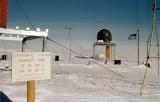
A new study shows that a spot in the heart of the West Antarctic Ice Sheet is
one of the fastest warming places on Earth.
The average temperature at the mile high Byrd station rose by 2.4 degrees
Celsius from 1958 to 2010. The rate of warming is nearly twice what earlier
indirect studies had suggested.
one of the fastest warming places on Earth.
The average temperature at the mile high Byrd station rose by 2.4 degrees
Celsius from 1958 to 2010. The rate of warming is nearly twice what earlier
indirect studies had suggested.
“It’s a big number — about as big as the most rapidly warming places
elsewhere on the planet,” says study coauthor David Bromwich, a polar scientist at Ohio State University in Columbus. “We were quite
surprised.”
Byrd warms faster in the winter and
spring as well as a statistically
significant temperature increase during
the summer bringing the interior of the
Antarctic closer and closer to the
melting point.
David Schneider, a
paleoclimatologist at the National Center for Atmospheric
Research in
Boulder, Colo. says “The impacts of warming here are potentially
huge.”
West Antarctica holds more water than the
Greenland does and melting from
both great ice sheets has already raised
sea levels 11 millimeters over the past
two decades.
spring as well as a statistically
significant temperature increase during
the summer bringing the interior of the
Antarctic closer and closer to the
melting point.
David Schneider, a
paleoclimatologist at the National Center for Atmospheric
Research in
Boulder, Colo. says “The impacts of warming here are potentially
huge.”
West Antarctica holds more water than the
Greenland does and melting from
both great ice sheets has already raised
sea levels 11 millimeters over the past
two decades.
The Navy established Byrd station in 1957. Weather observers measured
temperatures until 1975 where the station felling into disuse. In 1980
automated weather measurements began but due to gaps and changes in the way data on weather is collected many disregard the Byrd record as being to spotty to depend upon.
Bromwichs team took a second look since several indirect observations
suggested Weat Antarctica has getting warmer.bromwich and his team peiced
together the Byrd temperature data. Using the sophisticated computer simulation
and data analysis they filled in missing temperature observations. Nicolashas no
doubts its better than what was done before.
Bromwich says the temperatures at the station track closely with temperatures
over a wide swath of West Antarctica which suggests that the ice sheep may
approach melting much closer to the coast where the ice extends into the ocean
which easily destabilize and break apart. Such collapse help contribute to to the
rise in sea level.
“The Arctic is receiving a lot of attention right now, as it should,”
Bromwich says. “But what we are trying to emphasize here is that we need to pay
attention to the other end of the Earth as well."
temperatures until 1975 where the station felling into disuse. In 1980
automated weather measurements began but due to gaps and changes in the way data on weather is collected many disregard the Byrd record as being to spotty to depend upon.
Bromwichs team took a second look since several indirect observations
suggested Weat Antarctica has getting warmer.bromwich and his team peiced
together the Byrd temperature data. Using the sophisticated computer simulation
and data analysis they filled in missing temperature observations. Nicolashas no
doubts its better than what was done before.
Bromwich says the temperatures at the station track closely with temperatures
over a wide swath of West Antarctica which suggests that the ice sheep may
approach melting much closer to the coast where the ice extends into the ocean
which easily destabilize and break apart. Such collapse help contribute to to the
rise in sea level.
“The Arctic is receiving a lot of attention right now, as it should,”
Bromwich says. “But what we are trying to emphasize here is that we need to pay
attention to the other end of the Earth as well."

 RSS Feed
RSS Feed